
views
Gargling with a Salt-Water Treatment

Decide what to gargle with. Most people choose to simply stir one teaspoon of table or sea salt into eight ounces of warm water. The salt draws water out of the swollen tissues, reducing swelling. If you can deal with a bad taste, consider adding your teaspoon of salt to a mixture of equal parts warm water and apple cider vinegar. Though there’s no clear explanation for it, apple cider vinegar seems more effective than other vinegars at soothing sore throats. It’s thought that the acid in the vinegar kills the bacteria. A third option is to add ½ teaspoon of baking soda to your salt-water mixture.

Add honey or lemon to improve the taste. Honey has antibacterial properties to fight bacterial infection. It can also soothe your sore throat and improve the taste of unpleasant treatments. Lemon contains Vitamin C to boost your immune system, but it’s also both antibacterial and antiviral. Don’t give honey to any child under the age of two. Young children may be susceptible to infant botulism, which can contaminate honey.

Use proper gargling technique. Both children and adults can benefit from gargling. However, you need to watch children to make sure they spit rather than swallow the mixture. If they do swallow a bit, don’t panic. Just have them drink a full glass of water. Give children a small amounts of mixture to gargle. Test children’s gargling ability with plain water before using the solution. Take the gargling mixture into your mouth and tilt your head back. Make an “ah” sound to create vibrations in your throat. You might have children say “GGGAAAAARRRRRRGGGGLLLE” instead. Do this for about 30 seconds. You should be able to feel the liquid moving around from the vibration — almost like it’s boiling in the back of your throat. Do not swallow any of the fluid. Spit it out and wash out your mouth when you’re finished.
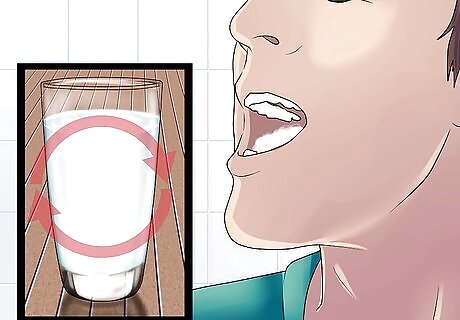
Gargle regularly throughout the day. Depending on what you’re gargling with, you may need more or less frequent gargling. Saltwater: once every hour Saltwater and apple cider vinegar: once every hour Saltwater and baking soda: every two hours
Using a Salt-Water Throat Spray
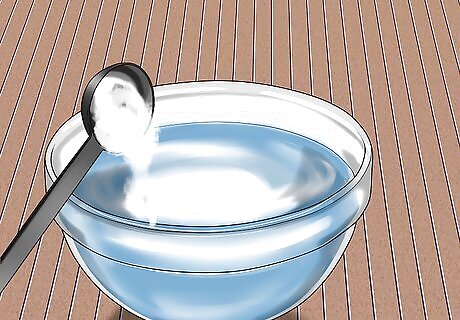
Make a salt-water solution. Making your own soothing throat spray is very simple — you don’t need to spend money at the store. All you need is ¼ cup of filtered water and ½ teaspoon of table salt or sea salt. Make sure the water is warm when you mix them together to encourage the salt to dissolve evenly.
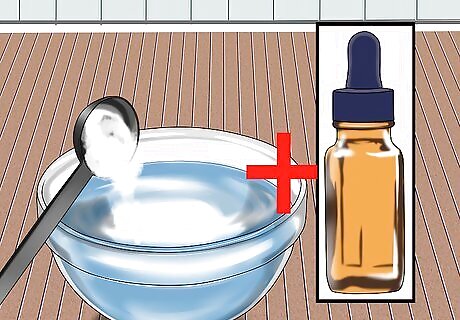
Add essential oils. A simple salt-water solution can be very soothing, but essential oils can speed up the healing process. Simply mix the essential oils well with the salt-water mixture. Two drops of any of the following essential oils can both relieve pain and fight the infection causing the sore throat: Menthol essential oil (pain reliever) Eucalyptus essential oil (antibacterial, antiviral, and anti-inflammatory) Sage essential oil (antibacterial, antiviral, and anti-inflammatory) Bergamot essential oil Do not ingest essential oils and spot test them on your skin to make sure you do not have an allergy. Even so, use caution, essential oils could react differently in your mouth.

Pour the ingredients into a spray bottle. A one or two ounce glass bottle with a spray attachment is ideal. This size will be small enough for you to carry around with you throughout the day. You can have it both at home and on the go.
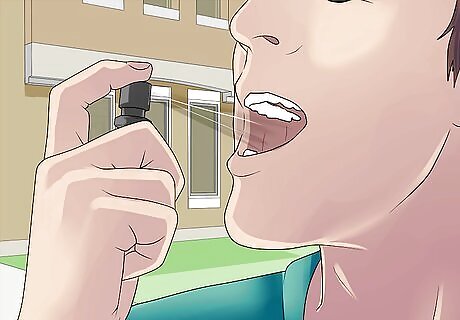
Use the spray as needed. When your throat feels particularly sore, pull out your spray bottle and give yourself a spritz. Open your mouth wide and aim the spray attachment toward the very back of your throat. Spray once or twice to soothe your irritation.
Using Other Methods of Treatment
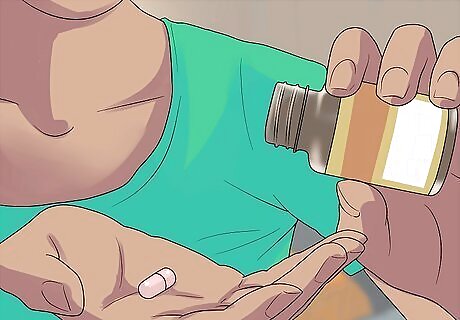
Take antibiotics for a bacterial infection.While viral infections don’t respond to antibiotics, bacterial ones do. If your doctor diagnoses you with a bacterial infection, ask for a prescription for antibiotics. Make sure to take the antibiotics exactly as prescribed. Don’t stop taking them before you’ve finished the full course, even if you start feeling better. You may leave yourself open to complications or a recurrence of the infection. Eat yogurt with active cultures (probiotics) while on antibiotics. Antibiotics kill off healthy gut bacteria while fighting the infecting bacteria. Eating yogurt with active probiotic cultures will replace the normal gut bacteria, helping your body fight off the infection.

Stay hydrated. Drinking water moisturizes the external skin on your throat, but it also keeps your whole body hydrated. This soothes the irritation from within the tissue as well. Drink eight to ten 8 oz. glasses of water every day. Another way to moisturize your throat is to keep the air you’re breathing as humid as possible — especially if you live in a dry climate. Buy a humidifier or place bowls of water in rooms where you spend a lot of time.

Eat foods that easy to swallow. Broths and soups are not only easy to swallow — they’ve also been shown to improve immune response. They do this by slowing down the movement of immune cells, which makes them more effective. If you want more variety in your meals, just make sure you stick to soft, easy-to swallow foods: Applesauce Rice or well-cooked pasta Scrambled eggs Oatmeal Smoothies Well-cooked beans and legumes
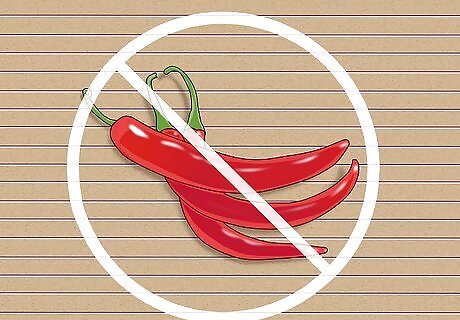
Avoid foods that will irritate your throat. Avoid spicy foods at all costs, as they will make your throat pain much worse. The definition of spicy is broad; you might not think of pepperoni or garlic as spicy, but they will irritate your condition. Also avoid sticky foods like peanut butter or hard foods like dry toast and crackers. Acidic foods like soda and citrus juices are also off limits until your throat heals.

Chew food thoroughly. Use a fork and knife to cut solid foods into small pieces, and chew food thoroughly to break it up. Chewing also gives your saliva time to break down the food and make it easier to swallow. If swallowing is very difficult, considering blending solid foods like cooked peas or carrots into a puree.
Diagnosing a Sore Throat

Recognize the symptoms of a sore throat. The most persistent symptom of a sore throat is throat pain that may get worse when swallowing or talking. It may also be accompanied by dryness or a scratchy feeling, and a hoarse or muffled voice. Some people experience sore, swollen glands in the neck or jaw. If you still have your tonsils, they may appear swollen or red, or have white patches or pus on them.

Look for other signs of infection. Most sore throats are the result of viral and bacterial infections. You should also look for the symptoms of infection that may accompany your sore throat. These can include: Fever Chills Coughing Runny nose Sneezing Body aches Headache Nausea or vomiting

Consider getting a medical diagnosis. Most sore throats will go away within a few days to a week with simple home treatment. If the pain is excessive or lingers, though, you should consider seeing a physician for a physical exam. The doctor will look at your throat, listen to your breathing, and take a throat swab for a rapid strep test. While the swab is painless, it can be slightly uncomfortable if it causes a gag reflex. The sample taken from your throat swab will be sent to a lab to figure out the cause of the infection. Once the virus or bacteria causing your throat pain is determined, the doctor can advise you on treatment. Medications that are used to treat a sore throat caused by bacteria include penicillin, amoxicillin, and ampicillin. The doctor may also order a CBC (complete blood count) or test your for allergies.

Learn when to get immediate medical attention. Most sore throats don't suggest serious medical conditions. Children, though, should always be checked out by a doctor if a sore throat doesn't go away with a drink of water in the morning. You should call your doctor immediately if your child has trouble breathing or swallowing. Unusual drooling accompanied by a sore throat should also be examined as soon as possible. Adults are better at gauging whether they need medical attention. You can wait it out at home for a few days, but see a doctor if you experience: A sore throat that lasts longer than a week or seems severe Any difficulty swallowing Any difficulty breathing Any difficulty in opening your mouth or pain in the jaw joint Joint pain, especially new pains Earache Any rash A fever higher than 101 F (38.3 C) Any blood in your saliva or phlegm Frequently recurring sore throats A lump or mass in your neck Hoarseness that lasts more than two weeks
















Comments
0 comment